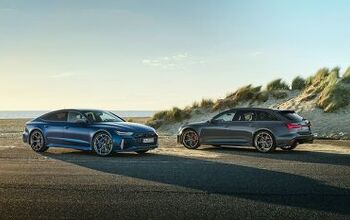Non-Detroit Three Automakers Already Sell More Cars in North America, and Soon They'll Make More

Detroit’s dominance in the domestic automotive sphere continues to erode. Whereas the manufacturing hub, home to Ford, General Motors, and Fiat Chrysler Automobiles, once churned out the bulk of vehicles built — and sold — in the United States, times have changed.
The former Big Three automakers no longer hold the majority market share in the U.S. (in 2016 it was 44.9 percent), necessitating a name demotion to “Detroit Three.” From Silicon Valley to the Midwest and South, a diverse group of automakers is busily assembling cars and SUVs for a population with very wide-ranging tastes. We’ve long since become used to the idea that many Hyundais now hail from Alabama, several Subarus come from Indiana, Honda models grow in Ohio, and BMWs arrive from South Carolina with a Southern drawl.
Now, one industry watcher claims the Detroit Three won’t even finish the year as the majority builder of North American-made vehicles.
According to IHS Markit, Detroit will soon hand over the crown to its domestic and foreign rivals, Bloomberg reports.
In a briefing held today on the outskirts of that city, IHS Markit analyst Joe Langley predicted a total of 8.6 million vehicles produced in North America by Ford, GM, and FCA in 2017, just a hair below the 8.7 million vehicles forecasted for all other manufacturers. The rival group includes Tesla, as well as German, Japanese, and Korean automakers.
With several automakers — Toyota, Mercedes-Ben z, and Volvo, for example — announcing production expansions in just the past week, the gap will only grow after this year’s anticipated turning point. It’s truly Detroit vs. Everybody, and everybody’s winning. By 2024, IHS Markit seed the Detroit Three building 8.1 million vehicles in North America, compared to 9.8 million units assembled by the competition.
It’s been a long time coming. After the disappearance of such automakers as Studebaker, Packard, and Kaiser in the 1950s and ’60s, as well as the purchase of AMC by Chrysler in the 1980s, Detroit’s production dominance soon sprouted cracks. Japanese manufacturers arrived on masse in the ’80s, setting up shop in states unfriendly to the United Auto Workers. The Germans and Koreans eventually followed.
Since the recession, all three Detroit automakers have begun looking outward for opportunities, hoping to gain market share outside North America’s borders. At the same time, the number of models sent to Mexico for low-cost production has increased, all in the interest of profitability.
Unfortunately for the Detroit Three, Mexico has also welcomed other manufacturers with open arms.
[Image: Bryan Debus/ Flickr]

More by Steph Willems
Latest Car Reviews
Read moreLatest Product Reviews
Read moreRecent Comments
- Analoggrotto Does anyone seriously listen to this?
- Thomas Same here....but keep in mind that EVs are already much more efficient than ICE vehicles. They need to catch up in all the other areas you mentioned.
- Analoggrotto It's great to see TTAC kicking up the best for their #1 corporate sponsor. Keep up the good work guys.
- John66ny Title about self driving cars, linked podcast about headlight restoration. Some relationship?
- Jeff JMII--If I did not get my Maverick my next choice was a Santa Cruz. They are different but then they are both compact pickups the only real compact pickups on the market. I am glad to hear that the Santa Cruz will have knobs and buttons on it for 2025 it would be good if they offered a hybrid as well. When I looked at both trucks it was less about brand loyalty and more about price, size, and features. I have owned 2 gm made trucks in the past and liked both but gm does not make a true compact truck and neither does Ram, Toyota, or Nissan. The Maverick was the only Ford product that I wanted. If I wanted a larger truck I would have kept either my 99 S-10 extended cab with a 2.2 I-4 5 speed or my 08 Isuzu I-370 4 x 4 with the 3.7 I-5, tow package, heated leather seats, and other niceties and it road like a luxury vehicle. I believe the demand is there for other manufacturers to make compact pickups. The proposed hybrid Toyota Stout would be a great truck. Subaru has experience making small trucks and they could make a very competitive compact truck and Subaru has a great all wheel drive system. Chevy has a great compact pickup offered in South America called the Montana which gm could make in North America and offered in the US and Canada. Ram has a great little compact truck offered in South America as well. Compact trucks are a great vehicle for those who want an open bed for hauling but what a smaller more affordable efficient practical vehicle.


































Comments
Join the conversation
I couldn't care any less about who makes cars in North America or in what quantity. I do care about who makes cars in the United States of America. Lets see those numbers, and only those numbers. I suspect it will just go to show the UAW three to be even further behind other US employers.
Just for perspective: GM, at its peak, had something approaching 50% market share.